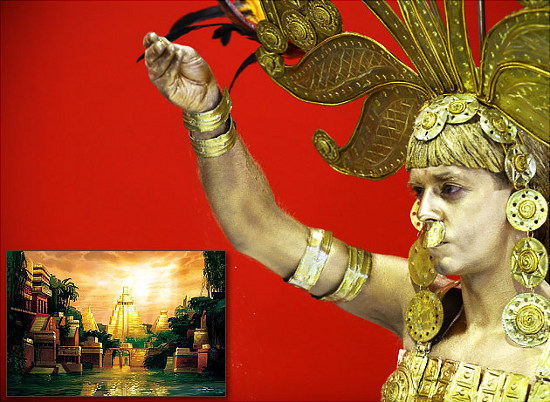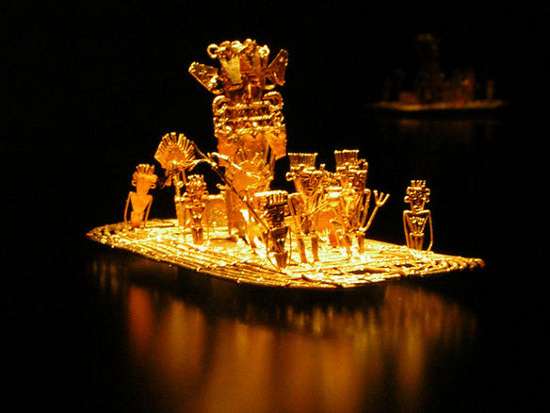The legend of El Dorado – the gilded city on Lake Guatavita (present-day Colombia) dates back to the Middle Ages, beckoning many brave explorers to set out even though many departed never to return.
Tales of the gilded city began when Colombo discovered the Americas. Around the 16th century, Europeans increasingly believed that in the new continent (ie America) there was a city full of gold. At that time, El Dorado through stories had many different locations, but in the end, explorers all assumed that this city was located next to the Guatavita volcanic lake, in the middle of the mysterious Amazon jungle.
Columbus’ arrival in the Americas in 1492 was the first chapter in a cultural clash that changed the world. It is a brutal battle of two completely opposite lifestyles and belief systems.
Legend of the Europeans said that El Dorado is a lost city of gold and waiting to be discovered by explorers. That reflects the Europeans’ endless desire for gold and their motivation to exploit new lands to reap riches.
Meanwhile, the South American legend of El Dorado reveals the true nature of this city and the people who live there. To South Americans, El Dorado was never a place, but a wealthy leader . This person is said to have a habit of covering his body with gold from head to toe every morning and washing them in a sacred lake in the evening.
 El Dorado is actually a leader of the Muisca people who like to be covered in gold, not the golden city as the legend goes.
El Dorado is actually a leader of the Muisca people who like to be covered in gold, not the golden city as the legend goes.
The truth behind the legend has been slowly unraveling in recent years, as scientists combine long-established historical documents and new archaeological research. At the heart of the legend of the golden city is the true story of a ritual performed by the Muisca people, who lived in Central Colombia from AD 800 to the present day.
Various Spanish historians traveled to this strange continent in the early 16th century to document this ritual of El Dorado and one of the best is that of Juan Rodriguez Freyle. In Freyle’s book The Conquest and Exploration of the New Kingdom of Granada, published in 1636, the historian said that when a leader in the Muisca community died, a “golden figure ” would is selected and the inheritance process takes place.
The newly chosen leader, usually the grandson of the deceased, will attend a lengthy succession ceremony that culminates in rowing a boat on a sacred lake, similar to Lake Guatavita in central Colombia.
Surrounded by the four highest-ranking priests dressed in feathers, crowns of gold, and full of jewels, the new leader, naked but covered in gold dust, will conduct a ritual sacrifice of gold and silver. to the gods by throwing them into the lake.
On the shore of the lake, many people stood watching the ceremony, playing musical instruments and lighting fires from pots. On the raft, there are also 4 flames that emit incense smoke into the sky. When the raft reached the middle of the lake, the priest would wave a flag asking the crowd to be quiet. This is the time when the crowd shows allegiance to the new leader by chanting support from the lakeshore.
Through a number of archaeological studies, many aspects of the above event have been confirmed to be true. There is also research showing the great skill and scale of gold production in Colombia at the time of European arrival in the Americas in 1537.
To the Muisca, gold or more specifically a mixture of gold, silver and bronze was called tumbaga. These metals are valued not for their physical value but for their spiritual value. They were said to have the ability to connect with the gods and bring balance and harmony in Muisca society.
 A Muisca gold item.
A Muisca gold item.
As a descendant of the Muisca people, Enrique Gonzalez, explains, gold does not symbolize prosperity. “For the Muisca people today, as well as our ancestors before, gold is only valuable as an offering and does not represent wealth.”
Recent studies by Maria Alicia Uribe Villegas at the UCL Archaeological Institute show that the Muisca created gold items as sacrifices to the gods , in order to ask them to create balance in the universe. and ensure environmental stability.
According to archaeologist Roberto Lleras Perez, an expert on gold and the Muisca belief system, the Muisca making and use of gold was very different in South America. “As far as I know, so far no other society has used 50% of the gold produced for sacrifice. I think that’s special ,” Perez said.
Since all the gold items in each sacrifice have similar chemical characteristics and distinctive features, it means that these items were made specifically for a single sacrifice and only last for a few hours or days. before being thrown away.
In particular, the drawing of a golden raft exactly as described in the book by Juan Rodriguez Freyle, was found by 3 villagers in a small cave south of Bogota in 1969. The drawing shows a man covered in gold coming out. a sacred lake. That confirms the true story of El Dorado.
 Description of the golden city El Dorado according to European legend.
Description of the golden city El Dorado according to European legend.
The fact that El Dorado was turned into a legendary gold city shows the lust for precious metals of the European conquerors. They know very little about the true value of Muisca society. The minds of Europeans are simply overwhelmed by the sight of so much gold being thrown into the lake water and buried in sacred sites in Colombia.
In 1537, the myth of El Dorado attracted the Spanish conquistador, Jimenez de Quesada and his army of 800 men, on a mission to find an overland route to Peru and his Andean homeland. the Muisca for the first time.
Quesada and his soldiers were lured deep into strange, inhospitable lands and claimed many lives. However, what Quesada’s army found surprised them, as the Muisca’s gold was unlike anything they had seen before. Exquisite gold items crafted with unique techniques never seen before in Europe.
Unfortunately, the hopeless gold hunt persists to this day. Archaeologists around the world are fighting to stop looting from increasing. Like the European conquistadors of the 16th century, their clones continue to loot South America’s past and take away the wonderful stories behind the Muisca gold.
The amount of gold found by modern robbers is astounding. During the 1970s when new locations were discovered by thieves in northern Colombia, the world gold market wobbled.
The Muisca looting of precious metals meant that a large amount of pre-Columbian gold was melted down and lost their archaeological value to the ancient culture forever.
Fortunately, several other gold collections are housed at the Museo del Oro in Bogota, Colombia, and the British Museum in London, England. They contribute to providing a clear view of the Muisca’s different conception of material values, human perception and most importantly, tell us the true story of the El Dorado legend.